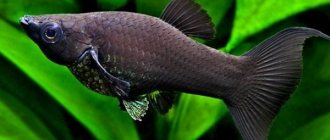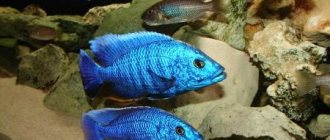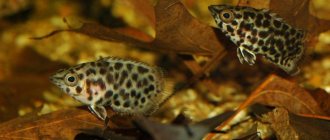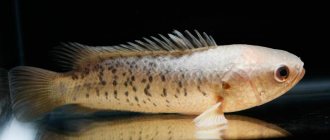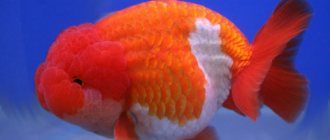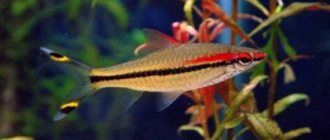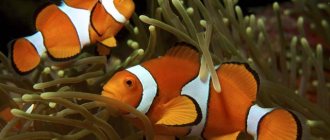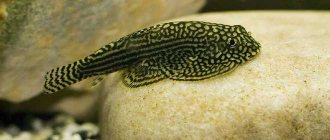Mastacembel armatus, also called Mastacembel coffee for its beautiful brown body color, is an aquarium pet of Asian origin. The family Mastacembelus (proboscis snouts) was discovered in 1800. Outwardly, mastacembel is similar to an eel, but has nothing to do with it; anatomically and physiologically it is closer to perches. The Red Banded Mastacembel is a large and beautiful aquarium species that only an experienced breeder can handle.
Habitat in nature
The natural habitat of mastacembela is large and small Indonesian, Vietnamese, and Pakistani rivers. The fish prefers to inhabit areas with abundant thickets of underwater plants and a sandy bottom, but is sometimes found in coastal swamps, lakes and flooded lowlands.
When living in nature, the fish leads a nocturnal hunting life, catching insects and worms, and during the day it rests, burrowing into the bottom sand.
In areas of its natural habitat, mastacembela is a commercial species used for food and is close to extinction, so it can be seen more often in aquarium conditions than in natural conditions.
Proper feeding
Feeding time occurs after sunset or in the evening, with minimal lighting. Feed the fish 2-3 times a week. Sometimes they may refuse to feed. If this happens occasionally, it is not a sign of a fish disease.
Mastacembels are fed 2-3 times a week
You need to feed your predator with protein food:
- worms;
- snails;
- bloodworm;
- krill;
- tubifex;
- shrimp meat;
- pieces of fish.
Mastacembel also eats frozen protein foods, but not very willingly. He eats dry food even less willingly. Such food can be used from time to time, but live food is also needed for the health of the fish.
Description
Mastacembela oribatis is a large representative of Asian proboscis fish, growing up to 80 cm in nature, but in an aquarium its body length does not exceed 40-50 cm.
How much a fish costs depends on its size. The price per individual ranges from 150 rubles (10 cm) to 1500 (80 cm).
External characteristics of the type:
- The body is elongated, like an eel;
- The muzzle is a movable proboscis - an organ of touch that helps to grope for food;
- The scales covering the body are small and soft, so the skin is additionally protected by the toxic mucus secreted;
- The anal and dorsal fins are elongated, merging with the caudal fin.
A notable feature in describing the appearance of mastacembela is its beautiful color. The body of the fish is covered with a bizarre pattern. There are Asian and Indian species. The first has a coffee-colored body, the patterned covering consists of large ring-shaped spots, the second, bred in 1923, has a light color and a pattern of zigzags on the sides.
You should not iron mastacembela. Firstly, you can get injured by the spines of the anal and dorsal fins, and secondly, the skin of the fish is unpleasant to the touch, reminiscent of sandpaper.
Kinds
Proboscis snouts include several species of these fish. Each of them is a rather rare guest in aquariums. However, they still have their place in the aquarium world:
Armatus or armored mastacembelus
Mastacembelus armatus
Lives in Central and Southeast Asia. According to the conditions of detention, he is not singled out. That is, the aquarium should be at least 200 liters, the water should be warm and soft. The record individual reached a length of 70 cm, but, as a rule, these eels grow no more than 40 cm. The body has a chocolate-olive color with an interesting ornament. It resembles many rings, although towards the tail they break apart, forming simply spots. Like other species, the fish has spines on its dorsal and anal fins, so it is better not to touch it with your hands;
Mastacembel redstriped
Mastacembelus erythrotaenia
Its homeland is Myanmar (Burma), Malaysia and Thailand. For one individual you need an aquarium of at least 300 liters, since this species is large. Fish grow up to 70 cm. Living conditions are standard. Body dark brown. Four red or orange stripes, consisting of spots and strokes, stretch along it. The intensity of the color changes, it depends on the conditions of the fish. Females are paler and larger than males;
Care and maintenance
Mastacembel armatus is a large pet, so it needs a large aquarium that can hold at least 200 liters of water per individual. Moreover, the tank should be elongated in width, not in height. A prerequisite is the presence of a tightly closing lid, since a nimble fish can slip even through a narrow hole and fall to the floor.
Mastacembelas have a painful time settling into a new aquarium; for several days they can hide in a shelter and refuse food. Therefore, it is important to immediately purchase a large tank for growth, and to buy a pet that has lived in a store aquarium for a long time and has managed to recover after transportation.
Water parameters
When kept in an aquarium, Mastacembel needs clean and air-saturated water. Fish swim mainly in the bottom layer, so the bottom needs to be cleaned regularly. Installation of a high-quality filter and aeration system is required. The water is changed weekly by 1/3.
Optimal water parameters:
- Temperature – 25-28°C;
- Acidity – 6.5-7.5 pH;
- Hardness – 5-15°dH.
Although the mastacembel is a freshwater fish, it likes slightly salted water. Therefore, you can add a teaspoon of sea salt per 10 liters of liquid.
Lighting
Mastacembelus prefers dim lighting. In bright light, he will constantly hide in shelters during the day.
Plants
Vegetation should be abundant, including both bottom-dwelling and floating broad-leaved species. It will create additional shading for the mastacembela.
Plants must have a strong root system, since the pet likes to burrow into the sand, uprooting the roots. It is better to plant the plants not in the bottom substrate, but in pots that are placed on the bottom.
Suitable vegetation:
- Cryptocoryne;
- Echinodorus;
- Water lily.
Priming
Fine sand is optimal as a soil. You can use quartz chips, but with a fraction of no more than 1 mm. The thickness of the bottom substrate must be at least 5 cm.
Decor
The red-striped mastacembel is a nocturnal species, so when arranging a tank, be sure to install shelters in which the pet can rest during the day: snags, grottoes, overturned pots, pipes.
Decorative items should not have sharp edges or corners, otherwise the fish will injure its body.
Range and Habitat
Asia: India, Thailand and Sumatra.
Mastacembel Armatus prefers rivers and streams with a sandy and rocky bottom, and in some places aquatic vegetation. Also found in lowland and coastal swamps.
During the rainy season during the summer months, they can be found in canals, lakes and other areas of flooded plains.
Compatibility
The behavior of the aquarium fish is peaceful and restrained. Ideal compatibility with large non-aggressive species, for example, cichlids and catfish; mastacembel simply does not pay attention to them. But small fish (less than 5 cm in length) will be perceived as food and will probably be eaten.
It is recommended to keep only one individual per tank. Firstly, coffee mastacembel is aggressive towards its relatives. Secondly, the fish is large, and finding an aquarium suitable in size for two individuals is problematic.
Appearance of individuals
Externally, Mastacembela armatus are very similar to eels:
- they have an elongated, snake-like body ;
- there is a long proboscis ;
- the dorsal and subcaudal fins are elongated, they are connected to the caudal fin;
- the body is brownish in color, covered with darkish or black stripes and spots. Each individual has its own individual color, which can vary significantly;
- The length of wild individuals reaches 90 cm, but aquarium inhabitants are much smaller, their length does not exceed half a meter.
The life expectancy of Armatus is 15-18 years.
Breeding and reproduction
Mastacembelas are ready to reproduce by the age of 3 years. What the finished female looks like: her belly is greatly swollen, and an ovipositor emerges a week before laying eggs.
Breeding in captivity is almost impossible. To breed offspring, the female has to take 2 injections of a gonadotropic agent, and the male has one.
Fish spawn in the morning, when it is still dark. The female releases sticky eggs in portions of 10-20 pieces. Only 15% of the fry survive. The young animals begin to be fed on the 9th day with live dust and small crustaceans.
Probability of getting fry
Only a few cases of successful production of offspring at home have been recorded.
Sex differences in fish are unknown, it is only assumed that the female is larger. You can only throw several individuals into a huge tank and hope that among the fish there will be different sexes. But the factor that triggers spawning is also unknown.
In addition, two separate aquariums are needed, where the male and female are previously kept. A huge spawning area is needed where the male can chase the female. Because of these difficulties, mastacembelas are bred only in nurseries.
Sexual maturity occurs in fish at three years. Individuals are given hormonal injections to induce spawning. The duration of spawning is several hours.
Caviar is lighter than water and sticky, which allows it to attach to floating plants. After 4 days the larvae appear, after another 4 days they turn into fry. The fry are fed live dust and Artemia nauplii.
Fry are very susceptible to fungal and infectious diseases. Despite maintaining high water quality and using antifungal drugs, the survival rate of fry is low.
Diseases and prevention
Mastacembela diseases are associated with deficiencies in hygiene and care. The body, covered with small scales, is susceptible to infection, ammonia and other harmful compounds in the water. Under unfavorable conditions, the pet becomes ill with ichthyophthyriasis, in which white spots cover the body. Treatment is adding methylene blue (2 mg per 1 l) and salt (3‰) to the water. Prevention - cleaning the aquarium, increasing filtration.
The fish painfully tolerates a sharp drop in temperature. She becomes lethargic and eats poorly. The likelihood of a fungal infection increases.
How long mastacembelas live depends on the conditions created. Life expectancy ranges from 8 to 16 years.
Mastacembel armatus is a pet for experienced owners, because caring for a large and capricious fish is not easy. But its beauty and originality make the eel-like aquarium fish a favorite of aquarists all over the world.
Spiny Eel Health
Mastacembela has small scales that poorly protect it from damage, infections, and parasites. Armatus does not tolerate low water temperatures. If it is below 22℃, then the fish will become lethargic and apathetic, and lose appetite. If the temperature is not raised to normal in time, fungal diseases are very likely. In these fish they are difficult to treat.
Lack of soil and dirty water will lead to the most common disease among mastacembelas - ichthyophthirius. You can recognize it by the white spots on the fish’s body. It affects not only the spiny eel itself, but also spreads among other fish.
Lack of soil and dirty water will lead to the most common disease among mastacembelas - ichthyophthirius
Quarantine required. The aquarium needs to be cleaned and undergo enhanced filtration. Add a solution of methylene blue (2 milligrams per liter) and table salt (up to 3 ppm) to the water. In advanced cases, you need to contact a specialist who will select suitable medications (not containing copper and zinc) and determine the required dosage. Careful care will help reduce the risk of disease to a minimum.
Keeping mastacembela armatus, although troublesome, is not a difficult task. Armatus is a fan of digging up plants, digging under stones, and decorative structures. But you can put up with constant aquarium chaos, because it shows that the fish are happy and comfortable.
This curious, active, somewhat timid fish recognizes “its” person and takes food from his hands. Mastacembel pleases the eye, swimming around the aquarium like an elegant exotic snake.
https://youtube.com/watch?v=nqOFsoWwrk8
